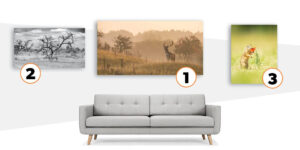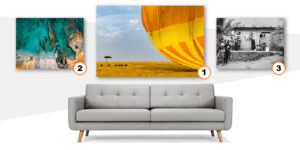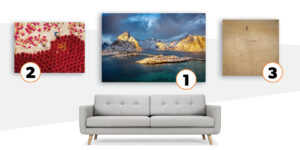So, you are looking to print your photo and hang it on the wall. Great idea, love it! During your search for the best material to print your photo on, you soon start to realise how many options there are. To make it even more difficult to choose, prices go from way too cheap to be any good, to good-looking but super expensive. Let’s see which material is best for your photo. After reading this article, you’ll know exactly which material is for you!
The most important things to consider when choosing a material for your wall print
In general, there are a few things you’ll need to take into account when choosing your material. The most important ones are:
- Shiny or matte surface – A shiny surface won’t work in all spaces, depending on the lighting conditions. Matte photo prints can be enjoyed on any wall, anywhere.
- Heavy/bulky or lightweight and thin – Do you want your photo easy to hang on any type of wall? And do you want a more refined look or big and bulky?
- Pricing – Pricing goes from a few bucks to hundreds, depending on quality and the size of the product.
- Print quality – Make use of all of those megapixels your camera has
Which materials to choose from?
There are many possible materials to print on, but we’ll talk about the 4 most popular materials, which are canvas, metal, Xpozer and acrylic. We’ve researched the materials carefully.
What’s the difference between photo prints on canvas, metal, Xpozer and acrylic?
Let’s start at the beginning, by explaining what these materials are exactly. I’ve put some pros and cons for each.
Jump to photo prints on canvas
Jump to photo prints on Xpozer
Jump to photo prints on acrylic
Your photo print on Canvas
A canvas is great for painters
Canvas is the name of a type of fabric, originally meaning ‘made of hemp’. Since the 14th century, the term ‘canvas’ has been used in the art world. Nowadays canvas is often made of linen or cotton, mixed with polyvinyl chloride (PVC). The canvas fabric was stretched over a wooden frame and didn’t necessarily require any kind of frame on the outside of the fabric. That’s the way canvas is used to this day. It’s a great material for oil painting. It was a cheaper alternative to the wooden panels that painters used at the time.
Should you use canvas for a photo print?
Fast forward to the 21st century. Even if canvas wasn’t originally created for printing, it still is a common choice for photo prints. Let’s see what the pros and cons are.
➕ Canvas is cheaper than most other materials
➕ Lightweight
➕ Canvas is 3D, and the photo goes over the sides (you either like it, or hate that it changes your photo’s composition).
➖ Canvas has a structured surface, so your photos can never be crispy sharp.
➖ A canvas print can not be rolled up and stored in a compact box.
➖ It can show dents, creases and wrinkles if not handled and store really carefully.
➖ It usually doesn’t come with a hanging kit.
Your photo print on metal (usually aluminium or dibond)
Why choose metal as a material for printing your photo?
The metal used for a photo print is usually a sturdy, but heavy material. It’s usually a coated aluminium panel. It’s quite thick, which is necessary to keep it from folding. The print usually isn’t perfectly smooth or flat. It actually has kind of a bumpy look, which clearly shows when direct light hits the print. To us perfectionists, that look makes it a rather non-ideal material to print high res photos on. When you order your photo on dibond, your photo is printed on a very thin sheet of metal. The product is actually sort of a sandwhich of two super thin meteal sheets with a polyethylene core.
➕ The material itself is strong (although scratches in the print are quite easily made)
➕ Metal prints usually come with different kinds of hanging systems to choose from.
➖ The hanging systems for metal prints all have their own prices, not always included in the product price they’re advertised with.
➖ Metal photo prints are expensive.
➖ The prints can’t be rolled or folded to be stored in a compact box.
➖ Metal photo prints are quite heavy, so not that easy to hang on the wall
Your photo print on Xpozer
What is Xpozer?
Now let’s check out what Xpozer is and what it’s pros and cons are. Xpozer is a fairly new product. In 2010, 2 photography fans who wanted to do something extraordinary with their photos and they developed Xpozer. They wanted to get rid of canvas’ bumpy, lumpy, structured fabric. They also didn’t like the super heavy or shiny metal or acryllic materials. Printing their photos on regular posters seemed cheap, but framing them to hang them on the wall without breaking the bank, turned out to be nearly impossible.
They just wanted the most crispy sharp, colorfast, matte material to print on, to get the best out of their megapixels and to be able to enjoy their photos from all angles and even in direct sunlight. They couldn’t find it, so they produced it themselves.
How does Xpozer work?
Xpozer is a new material, and you cannot really compare it to prior existing materials. It’s not paper, but it is thin. It’s a multi-layered material that Xpozer prints on. Those layers combined, make for a very strong material with a very flat surface, great to print all of those details on. There are no humps or bumps, no shine or visible frame. You stretch the Xpozer Print on the invisible Xpozer Frame. The end result is a flat, no-shine photo print, just shy of 2 centimeters off the wall. There’s no visible frame around the photo, but the Print itself casts an unobtrusive but indispensable drop shadow on the wall behind it, to mark the edges of the image.
Why should or shouldn’t you choose Xpozer?
➕ Lightweight, possibly the lightest of all materials.
➕ An Xpozer always comes with a hanging kit to hang it directly on your wall.
➕ Xpozer has an invisible Frame to keep it flat against the wall.
➕ The Frame is reusable, so it’s easy and affordable to swap around your photos now and then.
➕ The Print has a flat surface, no amount of light spoils the enjoyment of your crispy sharp photo.
➕ Xpozer has an evergreen offer for a free Frame with 4 Xpozer Prints. The pack helps you swap your photos for a decent price, it’s called an Xpozer 4Pack.
➖ The Xpozer products are not the cheapest. Well, initially that is, because when swapping your photos out, you’ll see that having to only replace the print (you reuse the frame) it’s actually very good value for money.
➖ It is a lesser-known product, so you’ll need to step out of your comfort zone to try it out (maybe try a sample print first?).
Your photo print on acrylic
Why choose acrylic as a material for printing your photo?
Your photo printed on an acrylic material usually looks quite nice. The colors are mostly fine, the material makes a photo look quite sharp. There are a few obvious downsides, though.
➕ Acrylic is strong, but not usually scratch resistant.
➕ The print usually comes with a little hook on the back, for easy hanging.
➖ It’s quite expensive, compared to other materials.
➖ You can’t roll it up to store it in a compact box.
➖ Photo prints on acrylic material are super shiny. You can’t properly enjoy them during bright days or near windows.
Spot the differences between canvas, Xpozer, metal and acrylic
First: Can you guess which one is which?

Let me help you out. Clockwise, starting at the upper left: acrylic, canvas, metal and Xpozer. As you can see very clearly in the photo, 2 of the 4 materials win the reflection battle. Or they lose, whichever way you want to look at it 🙂
Canvas is matte, so you can look at it from all angles and you would still see the photo. It is not nearly as crisp as any of the other materials though, as it has a structured surface that makes it look much noisier.
Acrylic is a shiny, thick material, which can look good from the front, but can be nearly impossible to properly look at in brighter conditions.
Metal is almost as shiny as the acrylic. It is also quite heavy, compared to the other materials. The extra weight makes it a hassle to hang it on the wall. Also, its surface not completely smooth. That makes your photo look a lot less sharp.
Xpozer is matte, so you can see it from all angles. The material is thin, lightweight and smooth. The photo is crispy sharp.
So, which material is best to print your photo on?
Well, that’s a matter of taste, money and personal preference. If you want something cheap and you don’t care much for quality, go for a photo print on canvas. If you are all about quality, the best representation of your crispy sharp photo and the perfectly balanced colors you chose in post processing, go for Xpozer. Acrylic and metal are so shiny, you can’t enjoy your photo half the time. Except in darker spaces, maybe. Metal is quite sturdy, but acrylic and Xpozer are water resistant. Xpozer is even scratch resistant! So, taking all pros and cons into account, we’d recommend Xpozer. And I haven’t even discussed Xpozer’s top quality customer service yet 😀
Try it out for yourself! You’ll soon find out that Xpozer is the right choice for your photos, too. You have spent all that money on gear to make the best possible photos, you might as well print them on the best possible material and with the best printers, too.
When you are ready to try Xpozer, we recommend the Starter Pack deal. It gives you a great discount on your first Xpozer Print and Frame.
More from the Xpozer Blog:
Best apps for (landscape) photographers
This is how you prepare for your animal photoshoot
How to shoot abstract photos – tips and tricks









